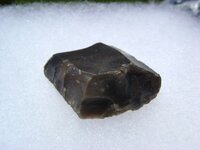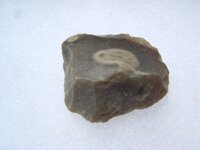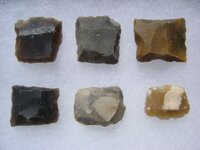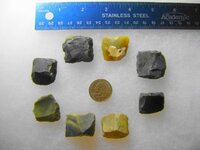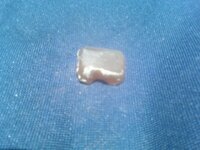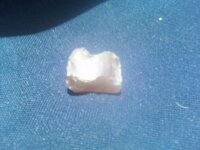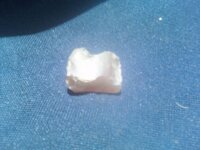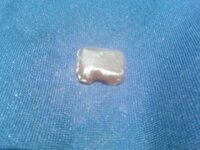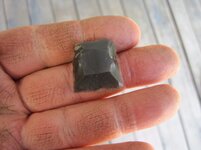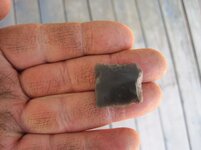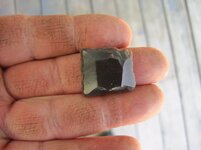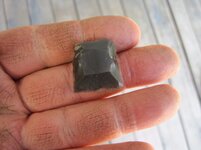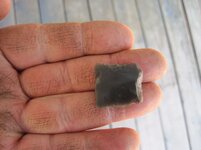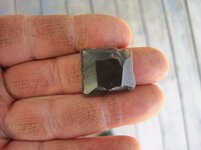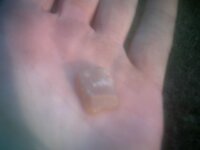Navigation
Install the app
How to install the app on iOS
Follow along with the video below to see how to install our site as a web app on your home screen.
Note: This feature may not be available in some browsers.
More options
You are using an out of date browser. It may not display this or other websites correctly.
You should upgrade or use an alternative browser.
You should upgrade or use an alternative browser.
Gunflints
- Thread starter Th3rty7
- Start date
The Grim Reaper
Gold Member
I was told that the dark colored ones are English flint and the honey colored ones are French flint. I only have one and it's honey colored French flint.
Adena_man
Hero Member
That is very cool! I have never found one in over 30 years of hunting. I also learned something new today - English vs French types of flint.
Awesome finds.
Awesome finds.
Buckhunter
Full Member
I am surprised you can find French gun flints. I would have thought they would run away!  Seriously though I have never found anything like that before. Do you think they would be less common in Missouri?
Seriously though I have never found anything like that before. Do you think they would be less common in Missouri?
 Seriously though I have never found anything like that before. Do you think they would be less common in Missouri?
Seriously though I have never found anything like that before. Do you think they would be less common in Missouri?Th3rty7
Silver Member
- Thread starter
- #10
RichPA said:What is the size of the average gunflints? Just curious.
They average about 1" x 1", some slightly bigger 1 1/4 " squared, some smaller 3/4" x 3/4", I tend to think the smaller are heavily used and discarded examples, or maybe for pistol flintlocks.
Thanks Docmann, and RGinn
Here's a few more with some scale reference.
Attachments
Th3rty7
Silver Member
- Thread starter
- #11
Buckhunter said:I am surprised you can find French gun flints. I would have thought they would run away!Seriously though I have never found anything like that before. Do you think they would be less common in Missouri?
LOL, well played. Not sure if they're common in Mo., mostly because I'm not aware of the history there. They didn't show up in America until after 1800. Here's a couple links I found on them with pictures and drawings of the 4 stages of English gunflints, pretty cool.
http://www.chippewanaturecenter.com/Oxbow/gunflints.htm
http://www3.interscience.wiley.com/journal/119534039/abstract?CRETRY=1&SRETRY=0
Harry Pristis
Bronze Member
Th3rty7
Silver Member
- Thread starter
- #15
j brown said:Nice!! gunflintsThirty7,
In this older thread of Larson's, about 3/4 way down the page , i give a little info i got from a book by T.M. Hamilton "Eighteenth Century Gunflints from Fort Michilimackinac and other Colonial sites". I think the website of Mackinac Parks, might still have it for sale, it's about 280 pages, alot of it is spark tests, etc. which kinda puts me to sleep, but there's alot of good stuff in there and i think it's only about $18.
Generally the honey colored to browns are probably French , the blacks to grays British, but there's cross-overs of each also, so the way they're manufactured can help tell what type they are. I've been able to type the ones i've found but if the edges are real battered and missing, from being used on strike-a-lights it's tough(for me) to tell the 2 prismatic blade types apart.
The Native American made ones are extremely rare and the ones Hamilton pictures are all bifacially chipped.
http://forum.treasurenet.com/index.php/topic,319735.0.html
Appreciate the info j.brown, good stuff. I think I have one that's bifacially worked , probably Native American made, I found it in WV. I need to picture that piece and post it.
Thanks for the comments folks, and adding other examples.
larson1951
Silver Member
here are pictures of the only one i found
thirty7 you have a nice assortment, thanks for posting
this one looks an awful lot your dark one at the lower left on your first image
larson1951
thirty7 you have a nice assortment, thanks for posting
this one looks an awful lot your dark one at the lower left on your first image
larson1951
Attachments
Jonzer
Hero Member
- Feb 12, 2010
- 541
- 55
- Detector(s) used
- Natural Eyeball Pressure
- Primary Interest:
- All Treasure Hunting
I think I have found these and threw them back down not knowing what they were.
I hunt a couple of civil war sites and have found a few war time artifacts.
Now I'm mad at myself.
I hunt a couple of civil war sites and have found a few war time artifacts.
Now I'm mad at myself.
O
Ohioan
Guest
truckinbutch
Silver Member
I have two softball size nodules of grey English flint that I have not attempted to work until my grandson and I learn more about working flint .
The limited amount of reading I have done indicates that the grey English was much sought after
as gunflint material for it's spark and longevity .
The limited amount of reading I have done indicates that the grey English was much sought after
as gunflint material for it's spark and longevity .
Th3rty7
Silver Member
- Thread starter
- #20
truckinbutch said:I have two softball size nodules of grey English flint that I have not attempted to work until my grandson and I learn more about working flint .
The limited amount of reading I have done indicates that the grey English was much sought after
as gunflint material for it's spark and longevity .
That stuff is really hard, I wouldn't recommend learning to knapp with it. It's really high grade but imo it's frustrating to work with.
Top Member Reactions
-
 3332
3332 -
 1930
1930 -
 1919
1919 -
 1186
1186 -
 1095
1095 -
 876
876 -
 804
804 -
 799
799 -
 795
795 -
 786
786 -
 766
766 -
 532
532 -
 489
489 -
 450
450 -
 449
449 -
 425
425 -
 423
423 -
E
412
-
 400
400 -
 394
394
Users who are viewing this thread
Total: 2 (members: 0, guests: 2)
Latest Discussions
-
Today's Finds 11-16-2024: Bucket lister and need help with date!
- Latest: E-Trac-Ohio
-
-
-


